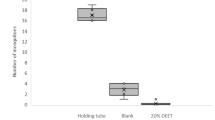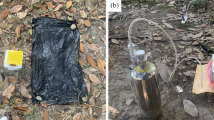Abstract
An apparatus has been assembled which permits storage and injection, at the same flow rate, of air containing human emanations into one port and air containing no emanations into the other port of a dual-port olfactometer, while monitoring the two flows for differences in temperature, relative humidity, and carbon dioxide level. Results of bioassays so conducted have led us to conclude that female mosquitoes (Anopheles quadrimaculatus Say) are attracted in significant numbers primarily by chemical emanations other than carbon dioxide and water.
Similar content being viewed by others
References
Acree, Fred, Jr., Turner, R.B., Gouck, H.K., Beroza, Morton, andSmith, Nelson. 1968.l-Lactic acid: A mosquito attractant isolated from mosquitoes.Science 161:1346–1347.
Bar-Zeev, M., Maibach, H.I., andKhan, A.A. 1977. Studies on the attraction ofAedes aegypti (Diptera: Culicidae) to man.J. Med. Entomol. 14:113–120.
Carlson, D.A., Smith, N., Gouck, H.K. andGodwin, D.R. 1973. Yellowfever mosquitoes: Compounds related to lactic acid that attract females.J. Econ. Entomol. 66:329–331.
Clements, A.N. 1963. The Physiology of Mosquitoes. Macmillan, New York. 393 pp.
Price, George D., Harris, R.H., andSmith, J. 1978. An uncommon system for manual control of olfactometer air relative humidity.J. Med. Entomol. 14:715–716.
Schreck, C.E., Gouck, H.K., andSmith, N. 1967. An improved olfactometer for use in studying mosquito attractants and repellents.J. Econ. Entomol. 60:1188–1190.
Smith, C.N., Smith, N., Gouck, H.K., Weidhaas, D.E., Gilbert, I.H., Mayer, M.S., Smittle, B.J., andHofbauer, A. 1970.l-Lactic acid as a factor in the attraction ofAedes aegypti (Diptera: Culicidae) to human hosts.Ann. Entomol. Soc. Am. 65:607–612.
Wright, R.H. 1975. Why mosquito repellents repel.Sci. Am. 233(1):104–111.
Author information
Authors and Affiliations
Additional information
Diptera: Culicidae.
The research reported in this manuscript was conducted in part with contract funds transferred from the Medical Research and Development Command, Office of the Surgeon General, U.S. Army. Mention of a commercial or proprietary product in this paper does not constitute an endorsement of this product by the USDA.
Rights and permissions
About this article
Cite this article
Price, G.D., Smith, N. & Carlson, D.A. The attraction of female mosquitoes (Anopheles quadrimaculatus Say) to stored human emanations in conjunction with adjusted levels of relative humidity, temperature, and carbon dioxide. J Chem Ecol 5, 383–395 (1979). https://doi.org/10.1007/BF00987924
Received:
Revised:
Issue Date:
DOI: https://doi.org/10.1007/BF00987924




